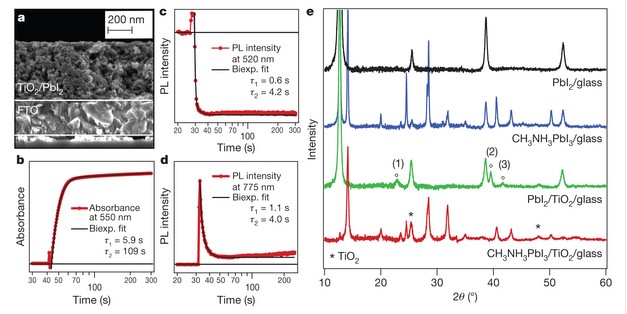一、本期重点:
doi:10.1126/science.1235547
published:2013.06.14
内容介绍:
二维原子晶体的出现在基础和应用领域都具有重要意义。作为其中的重要一员,过渡族金属二硫属化物(TMDCs)具有从半导体到金属,从电荷密度波到超导等一系列优良的电学性质,此外,由于具有较强的光吸收(可见光波段大于107 m-1,即300nm厚的薄膜可以吸收95%的入射光)、(WS2)良好的化学稳定性以及带隙位于可见波段等优点,其在光伏领域也具有较好的应用前景;然而,需要设计PN结分离电子空穴对来抽取光电流这一困难也阻碍了其发展。
而本文作者通过设计基于二维晶体的垂直方向的异质结构,将作为良好感光材料的TDMCs和作为良好透明电极的石墨烯结合起来,做出的电池具有0.1A/W的光电响应度和大于30%的外量子效率。他们的器件具有石墨烯/TMDC/石墨烯(两层石墨烯具有不同的掺杂)的堆栈结构,I-V曲线显示其电池特性强烈依赖于光照条件,在黑暗条件下其I-V具有很强的非线性;而在光照时,电池电阻降低三个数量级,并且在零偏压的附近具有线性I-V响应。
仿真和理论分析结果表明,TMDCs的态密度(DoS)和联合态密度在可见光波段较强的峰值和DoS的范霍夫奇点均对该器件增强的光学吸收有贡献。

图一 器件结构和光电流图像
doi:10.1038/nature12340
published:2013.07.18
内容介绍:
目前常用的制作钙钛矿的方法是将PbX2和CH3NH3X(X=Cl,Br,I)在常用溶剂中溶解并单步沉积到多孔氧化物薄膜上,这种过程不可控的方法会导致钙钛矿的表面形貌产生较大变化进而对制作的太阳能电池的多个性能产生影响。
本文报道了一种在多孔金属氧化物薄膜中形成钙钛矿染料的连续沉积的方法,他们用这种技术制作出的太阳能电池有高达15%的功率转换效率,并且具有很好的可再现性和较高的稳定性。
其连续沉积的核心步骤见下(制作太阳能电池的步骤详见文献附录METHODS SUMMARY):
1、在覆盖有透明导体氧化物的玻璃衬底上通过气溶胶喷雾热解方法沉积TiO2;
2、将胶体锐钛矿颗粒旋涂到30 nm厚的质密TiO2底层上;
3、通过在70℃环境中旋涂462mg·ml-1 PbI2 DMF溶液的方法将PbI2引入TiO2纳米孔;
4、将上述复合薄膜浸到10mg·ml-1 CH3NH3I的异丙醇溶液中,作者发现向钙钛矿的转化立刻在纳米孔宿主中快速发生,使得控制钙钛矿的形貌要容易得多。

图二 多孔TiO2薄膜上PbI2到CH3NH3PbI3的转化过程
二、简讯:
doi:10.1038/nature12289
published:2013.07.11
Abstract:
The ability to confine light is important both scientifically and technologically. Many light confinement methods exist, but they all achieve confinement with materials or systems that forbid outgoing waves. These systems can be implemented by metallic mirrors, by photonic band-gap materials, by highly disordered media (Anderson localization) and, for a subset of outgoing waves, by translational symmetry (total internal reflection) or by rotational or reflection
symmetry. Exceptions to these examples exist only in theoretical proposals. Here we predict and show experimentally that light can be perfectly confined in a patterned dielectric slab, even though outgoing waves are allowed in the surrounding medium. Technically, this is an observation of an ‘embedded eigenvalue’—namely, a bound state in a continuum of radiation modes—that is not due to symmetry incompatibility. Such a bound state can exist stably in a general class of geometries in which all of its radiation amplitudes vanish simultaneously as a result of destructive interference. This method to trap electromagnetic waves is also applicable to electronic and mechanical waves.
doi: 10.1038/NPHOTON.2013.136
published:2013.06.16
Abstract:
Low-cost renewable energies are necessary for the realization of a low-carbon society. Organic photovoltaics such as organic thin-film solar cells and dye-sensitized solar cells(DSSCs) are promising candidates for realizing low-cost solar cells. However, device efficiencies are still considerably lower than those of traditional inorganic solar cells. To improve organic photovoltaic performance, approaches are needed to extend the absorption of organic compounds to longer wavelengths. Here, we report efficient DSSCs that exploit near-infrared, spin-forbidden singlet-to-triplet direct transitions in a phosphine-coordinate.
d Ru(II) sensitizer, DX1. A DSSC using DX1 generated a photocurrent density of 26.8 mA·cm-2, the highest value for an organic photovoltaic reported to date. A tandem-type DSSC employing both DX1 and the traditional sensitizer N719 is shown to have a power conversion efficiency of>12% under 35.5 mW·cm-2 simulated sunlight.
doi: 10.1021/nl402392u
published:2013.08.07
Abstract:
Two times higher activity and three times higher stability in methanol oxidation reaction, a 0.12 V negative shift of the CO oxidation peak potential, and a 0.07 V positive shift of the oxygen reaction potential compared to Pt nanoparticles on pristine TiO2 support were achieved by tuning the electronic structure of the titanium oxide support of Pt nanoparticle catalysts. This was accomplished by adding oxygen vacancies or doping withfluorine. Experimental trends are interpreted in the context of an electronic structure model, showing an improvement in electrochemical activity when the Fermi level of the support material in Pt/TiOxsystems is close to the Pt Fermi level and the redox potential of the reaction. The present approach provides guidance for the selection of the support material of Pt/TiOx systems and may be applied to other metal-oxide support materials, thus having direct implications in the design and optimization of fuel cell catalyst supports.
doi: 10.1063/1.4802910
published:2013.06.24
Abstract:
We investigate a plasmonic resonant structure tunable from ultra-violet to near infrared wavelengths with maximum absorbance strength over 95% due to a highly efficient coupling with incident light. Additional harmonics are excited at higher frequencies extending the absorbance range to multiple wavelengths. We propose the concept of a plasmonic black metal nanoresonator that exhibits broadband absorbance characteristics by spacing the modes closer through increasing the resonator length and by employing adiabatic plasmonic nano-focusing on the tapered end of the cavity.
供稿人:寇鹏飞







